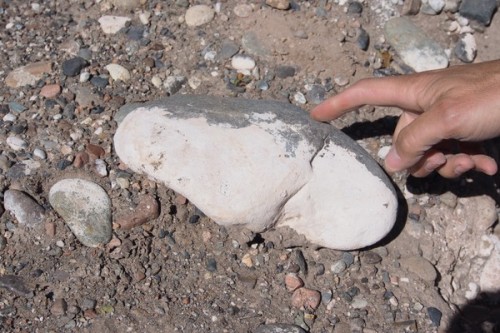
When it comes to vineyard soils, limestone is all the rage. But there’s one source of limestone in vineyard soils that isn’t much talked about. It’s the slow formation of limestone in arid vineyard soils, known as pedogenic (‘soil-created’) lime (and alternatively caliche and calcrete). I first encountered it in Central Otago, and then bumped into it again in Washington State. And this week, I was reintroduced to it in the soils of Mendoza, where it rains very little. Significantly, though, we were able to taste the difference that it makes to the final wine by looking at trial wines from Doña Paula, with viticulturist Martin Kaiser. These were Malbecs made from three different soil types in the Alluvia vineyard in Gualtallary.

So what is involved in calcification in arid vineyards? The rain absorbs carbon dioxide, producing carbonic acid. In the soil, this then produces calcium carbonate when it encounters calcium, which is almost always present to some degree as a result of the breakdown of parent material.

In arid areas this calcium carbonate remains in the soil, accumulating rather than being washed out (in areas with good rainfall, it would be leached out). After a long time – many thousands of years – enough has accumulated to produce a thick layer. This can form a pan (a firm layer of soil that roots can’t penetrate), and it also makes the soil more alkaline. If there are stones, these become covered on one side by the calcium carbonate. Where the soil is older, you see more of this calcification. If you take soils and squirt a bit of acid on them, you see the ones with calcium carbonate in them fizz. If there’s enough of this limestone material, it has an effect on vine growth and the flavour of the resulting wine, as these wines showed.

This limestone in the soil is quite different in origin to limestone soils as we commonly think about them, but it’s chemically the same. It’s really interesting that it can affect the flavour of wine. In the video, you can see Martin squirting acid on small piles of soil from different bits of the soil: the older material has some limestone, and fizzes rapidly. The younger material has accumulated less limestone and doesn’t fizz the same way.
Microvinifications with the same protocol. 2 weeks skin maceration, then old barrels for malolactic and then bottled straight afterwards.
Lot 111
129 water holding capacity, 36% stone percentage, 1.5% calcium carbonate, sandy without limestone. Fresh, pure black fruits with a slightly salty edge. Fruity and vivid. Hints of cherries and apples. Fresh fruit dominates here. Bright, simple, fruity style, with some floral overtones.
Lot 104
45 water holding capacity, 70% stones, 1% calcium carbonate, stony without limestone. Rich, quite vivid and chocolatey with some roast coffee hints and sweet, lush black fruits. Seems quite ripe and generous with some meaty richness.
Lot 102
31.7 water holding capacity, 74% stones, 4% calcium carbonate, stony with limestone.
Very bright, direct black cherry and plum fruit with a lovely core of acidity. Lovely focus and brightness here with lovely fruit purity. Really nice with a lovely acid core. Texturally brighter.
See also: a remarkable chalky vineyard in Gualtallary, planted by Edy del Popolo and David Bonomi.
Leave a Comment on Pedogenic lime in arid vineyard soils – how does it affect the flavour of wine?
